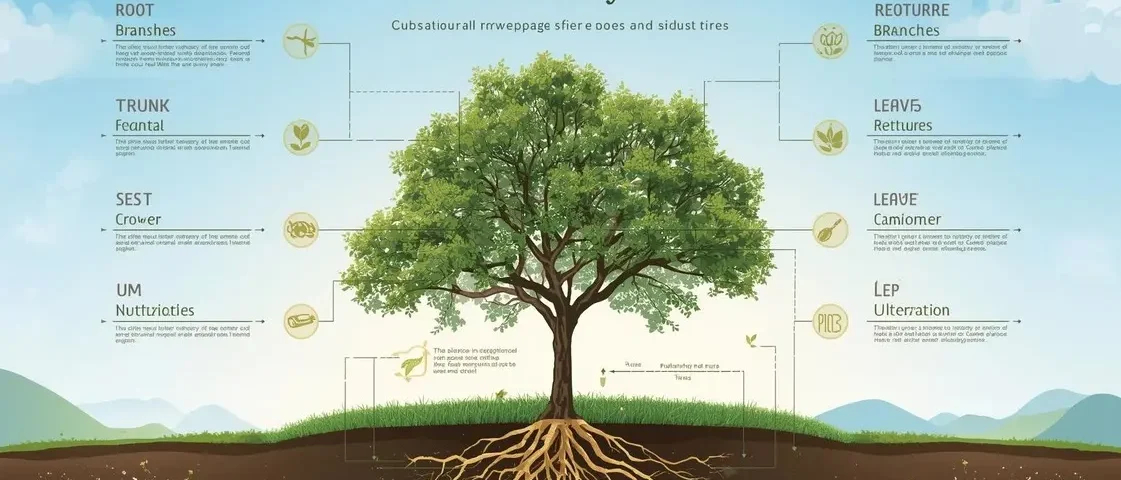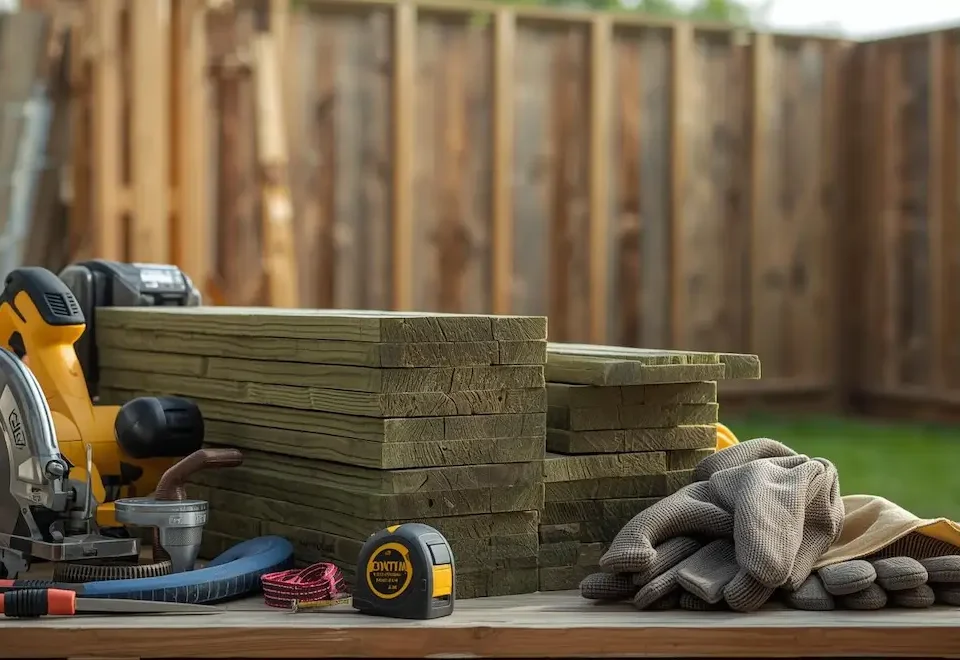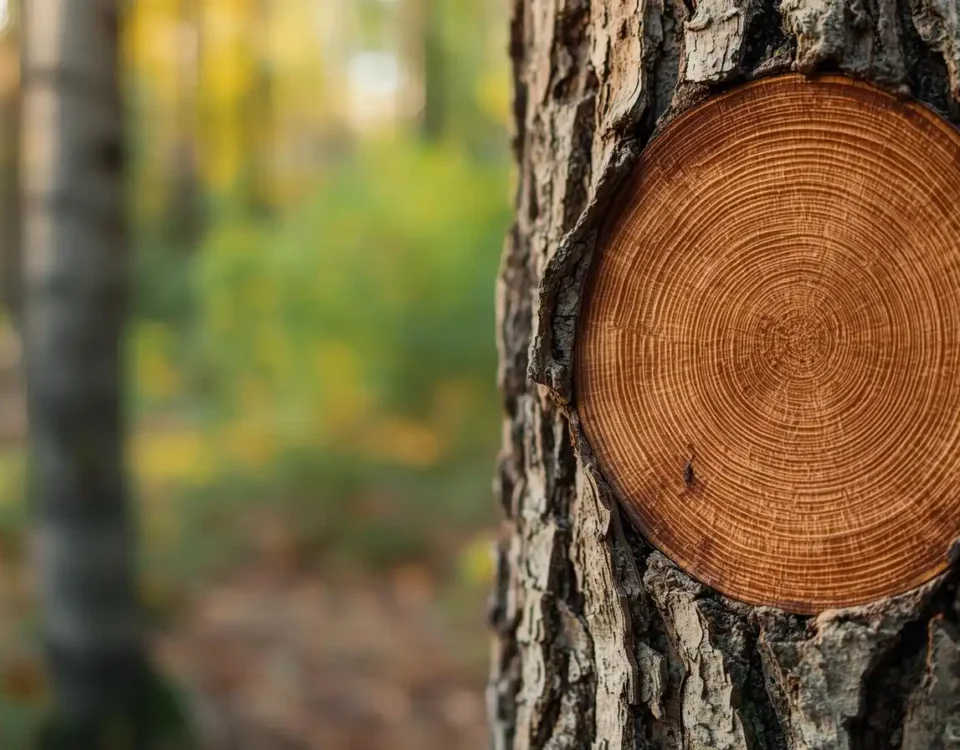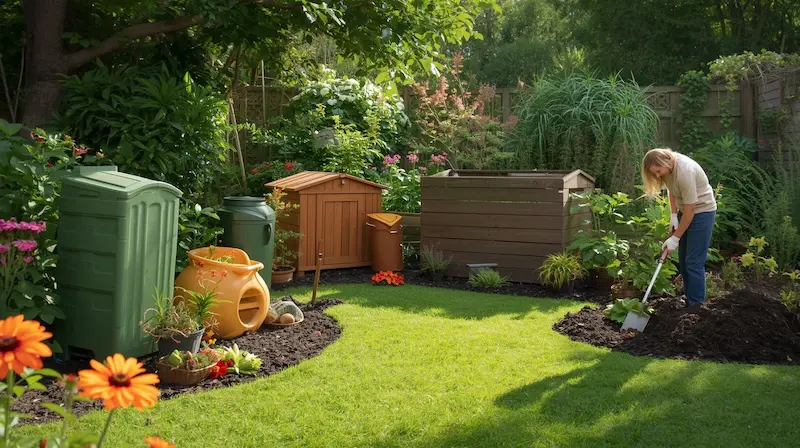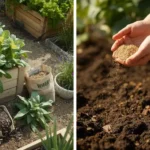
Guide to Organic Fertilizers for Your Home Garden Top Products, Tips
October 9, 2025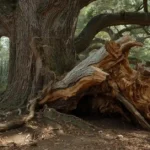
Sudden Branch Drop Syndrome Causes, Prevention & Management for Homeowners
October 11, 2025Have you ever paused beneath a towering oak or maple and wondered what truly makes it thrive? Beneath the familiar bark and canopy lies an intricate biological network roots drawing in nutrients, vessels transporting water, leaves converting sunlight into energy all working in perfect harmony to sustain life.
Yet without understanding how these systems interact, even the most well-intentioned tree care can miss the mark. Misguided pruning, inconsistent watering, or overlooking early signs of disease often stem from not grasping what’s happening inside the tree. The result? Struggling growth, premature decay, and unnecessary stress on a living organism built for balance and resilience.
This guide bridges that knowledge gap. By breaking down tree anatomy into clear, practical insights, you’ll learn how each part from root tips to leaf veins plays a vital role in overall health. You’ll also discover how to read your tree’s subtle signals, respond with informed care, and cultivate a deeper appreciation for the living architecture in your yard or garden.
Prepare to see trees not as static features of the landscape, but as dynamic systems of energy, structure, and life.
What is Tree Anatomy and Why Does It Matter?
Tree anatomy is the study of a tree’s internal and external structures everything from its underground roots to the finest veins in its leaves. It explores how these parts work together to absorb nutrients, transport water, store energy, and maintain stability. In essence, understanding tree anatomy means understanding how a tree lives, grows, and survives in its environment.
At its core, tree anatomy reveals a remarkable design. The roots anchor and draw up water and minerals; the trunk acts as the highway for nutrient transport; the branches extend the tree’s reach for sunlight; and the leaves transform light into energy through photosynthesis. Beneath the bark, a network of tissues xylem, phloem, and cambium forms the life-support system that keeps everything running smoothly.
This field of study is grounded in decades of arboricultural and botanical research from institutions such as the International Society of Arboriculture (ISA) and the U.S. Forest Service, both of which emphasize how a solid grasp of tree structure directly improves care and conservation outcomes.
Why It Matters for Tree Care
- Health & Maintenance: Knowing how a tree’s internal systems function helps you water deeply (reaching the roots that need it), prune safely (avoiding cuts that disrupt nutrient flow), and fertilize effectively (targeting areas that can absorb nutrients).
- Identification: Each species displays unique anatomical traits like bark texture, leaf arrangement, or branching pattern that aid in accurate identification.
- Diagnosing Problems: When bark cracks, roots suffocate, or leaves wilt, these are not random events they’re reflections of anatomical stress or dysfunction, such as browning arborvitae diagnosis. Recognizing where the issue lies enables quicker, more effective solutions.
- Ecological Insight: Anatomy also reveals a tree’s broader ecological role: how it stores carbon, provides habitat, and exchanges energy with the surrounding soil and air, contributing to the global forest count.
For many homeowners and gardeners, the biggest challenge is connecting visible symptoms yellowing leaves, peeling bark, or stunted growth to what’s happening inside the tree, especially for specific needs like Money Tree care. Learning the fundamentals of tree anatomy transforms that uncertainty into understanding, helping you care for your trees with both confidence and purpose.
The Major Parts of a Tree: An Overview
Every tree, no matter its species or size, follows a remarkably consistent blueprint. Its strength, longevity, and beauty all depend on a network of distinct yet interdependent parts each fulfilling a vital role in keeping the organism balanced and alive.
At the highest level, a tree can be divided into six main sections: roots, trunk, branches, crown, leaves, and reproductive parts. Together, these form a living system that connects soil to sky.
- Roots anchor the tree and absorb the water and nutrients it needs to grow.
- The Trunk provides stability and houses the vascular tissues xylem and phloem that transport water, minerals, and sugars throughout the tree.
- Branches extend from the trunk, distributing nutrients and supporting the canopy.
- The Crown the upper structure formed by branches and leaves captures sunlight and releases oxygen, driving photosynthesis.
- Leaves act as the energy factories, converting sunlight, carbon dioxide, and water into sugars that fuel growth.
- Reproductive Parts (such as flowers, cones, or seeds) ensure the continuation of the species, supporting pollination and new life.
Each component is more than a physical structure; it’s part of an integrated system that constantly communicates and adapts to the environment. Roots respond to soil conditions, leaves react to light and temperature, and the trunk adjusts growth patterns to balance strength and flexibility.
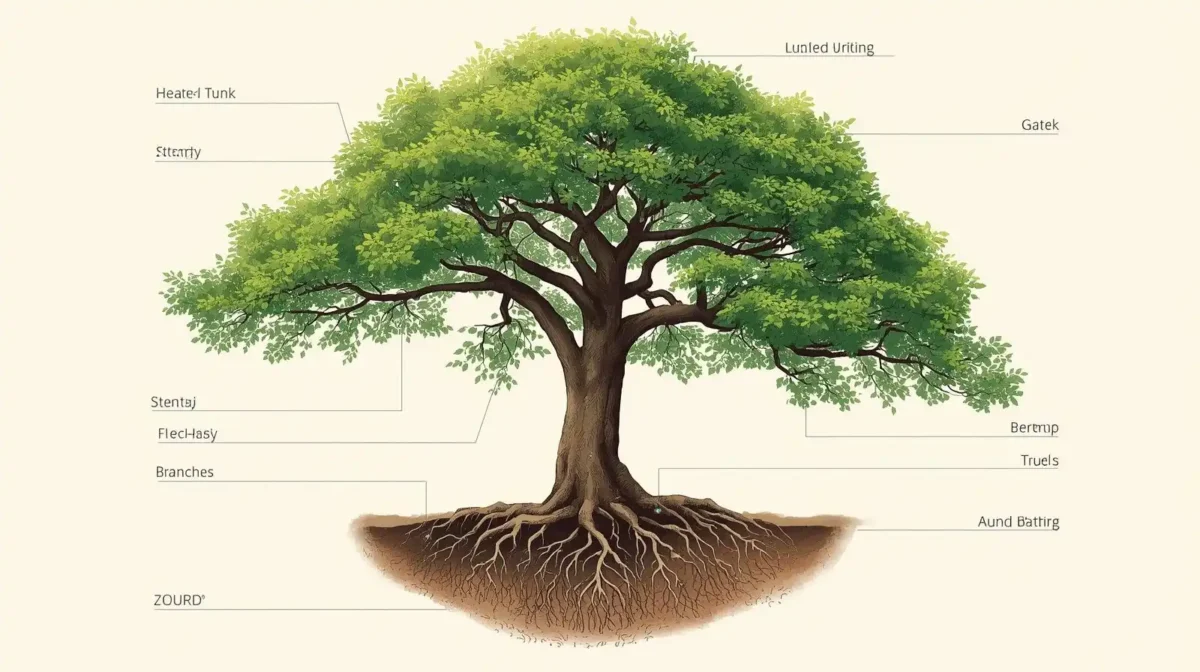
|
Tree Part |
Primary Function(s) |
Key Characteristics |
|
Roots |
Anchor the tree firmly in the soil; absorb water and minerals; store nutrients for future growth. |
Located underground in an extensive, branching network; fine root hairs increase absorption; root caps protect growing tips. |
|
Trunk (Stem) |
Provides support and stability; transports water, nutrients, and sugars between roots and leaves; stores energy. |
The main woody stem covered in bark; shows annual growth rings in cross-section; acts as the central pillar connecting roots to crown. |
|
Branches |
Support leaves, flowers, and fruits; serve as conduits for nutrient and water transport. |
Extend outward from the trunk; vary in size, thickness, and angle depending on species and light exposure. |
|
Leaves |
Carry out photosynthesis (converting sunlight into energy); regulate water through transpiration. |
Come in diverse shapes and sizes; green due to chlorophyll; contain a visible vein network for nutrient flow. |
|
Flowers, Fruits, and Seeds |
Enable reproduction and continuation of the species; attract pollinators and aid in seed dispersal. |
Often seasonal; specialized in form and color; contain the tree’s genetic material for new growth. |
|
Crown (Canopy) |
Captures sunlight; enables gas exchange; provides shade and habitat for wildlife. |
The upper mass of branches and leaves; overall shape varies by species (round, conical, spreading, etc.). |
Roots: The Anchors and Absorbers
Beneath every healthy tree lies a hidden world just as complex and vital as the canopy above. Roots do far more than hold a tree upright they are its lifeline, responsible for stability, nourishment, and communication with the surrounding soil ecosystem. Yet because they’re out of sight, root health is often overlooked until visible problems appear above ground.
The Structure of Roots
Not all roots are the same. Understanding their different types is the first step toward proper tree care:
- Tap Roots: A deep, central root that grows vertically into the soil. Common in species like oaks and pines, it provides strong anchorage and access to deep water reserves.
- Lateral Roots: These roots spread horizontally near the surface, helping most trees anchor firmly and explore a wide area for moisture and nutrients.
- Fibrous Roots: Found in many shrubs and some trees, this dense, shallow network efficiently captures rainfall and prevents soil erosion.
Each of these structures works together to balance support, absorption, and storage functions that are critical to a tree’s survival.
Core Functions of the Root System
- Anchoring: Roots stabilize the tree against wind, erosion, and storms, preventing it from toppling under stress.
- Water and Nutrient Absorption: Fine root hairs and partnerships with mycorrhizal fungi allow roots to absorb vital minerals and water from even the smallest soil pores.
- Storage: Roots store carbohydrates produced by leaves, ensuring the tree has energy reserves for growth and recovery during dormancy or stress.
- Gas Exchange: Like all living cells, roots need oxygen to respire. Compacted or waterlogged soil restricts this exchange, suffocating the roots and leading to decline.
Common Root Problems and How to Prevent Them
- Girdling Roots: Sometimes roots grow in circles around the trunk or other roots, slowly strangling the tree’s nutrient pathways.
Expert Tip – Beware of Girdling Roots: Early detection is crucial. Look for exposed or circling roots near the base; correcting them early can save the tree’s life. - Soil Compaction: Foot traffic, heavy machinery, or construction can compress soil, reducing air and water movement.
Expert Tip – Soil Is Life for Roots: Healthy soil with good structure and moisture balance supports robust root development and, in turn, a vigorous tree canopy. - Root Damage: Cutting or disturbing roots often during landscaping or construction can lead to water stress and canopy dieback.
Expert Tip – Roots Are Mirrors: The health of a tree’s crown reflects its root condition. Sparse leaves or discolored foliage often point to root injury or disease. - Water Stress: Overwatering can suffocate roots, while shallow, frequent watering encourages weak surface roots.
Expert Tip – Water Wisely: Deep, infrequent watering encourages roots to grow downward, improving drought resistance and structural stability.
Why Understanding Roots Matters
The root system is more than just a support structure it’s the foundation of every tree’s health. By learning how roots function and how soil composition affects them, you can diagnose issues like wilting, stunted growth, or yellowing leaves more accurately. Healthy roots lead to a thriving canopy, balanced nutrient flow, and resilience against pests and drought.
The Trunk: The Tree's Central Pillar
Standing tall between the earth and sky, the trunk is the tree’s backbone its primary support structure and life conduit. It holds the crown aloft, channels resources between roots and leaves, and shields the tree from pests, disease, and weather extremes. Yet despite its sturdy appearance, the trunk is far from solid wood throughout; it’s a living, layered system engineered for strength and survival.
Why the Trunk Matters
A healthy trunk not only keeps a tree upright but also maintains the steady flow of nutrients and water through internal vascular networks. Cracks, wounds, or decay in this central pillar can interrupt those pathways, leading to canopy decline, structural weakness, or even collapse during storms, including sudden branch drop syndrome.
Reading the Bark: Nature’s Health Report
The bark is the tree’s first line of defense protecting against insects, fungi, fire, and physical damage. But it also serves as a diagnostic tool for attentive observers.
Expert Tip “Read” the Bark: Bark isn’t just protection. Its texture, color, and pattern can reveal a tree’s age, species, and health. Smooth bark often belongs to young or fast-growing species, while rough or peeling bark may indicate maturity or, in some cases, disease or environmental stress.
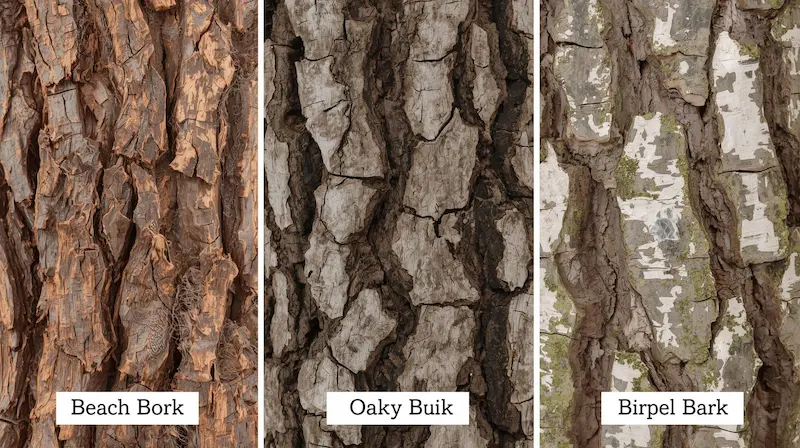
Inside the Trunk: Layers That Keep the Tree Alive
To truly understand how a tree functions, it helps to look inside beneath the bark to see how each layer contributes to life and structure.
|
Trunk Layer |
Function |
Description / Composition |
|
Bark (Outer) |
Protection, insulation |
Dead, corky outermost layer that shields the tree from insects, diseases, fire, and moisture loss. Texture and thickness vary widely by species. |
|
Bark (Inner / Phloem) |
Transports sugars (food) from leaves to roots |
A living, soft layer just inside the outer bark; carries carbohydrates produced during photosynthesis down to the roots. |
|
Vascular Cambium |
Produces new xylem and phloem cells |
A thin, living growth layer between wood and bark responsible for all new radial (outward) growth and the tree’s ability to heal wounds. |
|
Sapwood (Xylem) |
Transports water and nutrients from roots to leaves |
Living, lighter-colored wood that actively moves water and dissolved minerals upward through the tree. |
|
Heartwood |
Provides structural support and stores waste |
Dead, dense, and darker central wood that no longer conducts water but gives the trunk its strength and rigidity. |
|
Pith |
Stores nutrients during early growth |
A small, soft core at the very center important in young trees but gradually becomes less active as the tree matures. |
Expert Tip The Cambium Is Key: The cambium layer though only a few cells thick is the source of all new bark and wood. Damage from pruning wounds, lawn equipment, or pests that penetrates to this layer can permanently disrupt a tree’s ability to grow and heal.
The Tree as a System: An Engineering Marvel
Each layer of the trunk works in concert, forming a biological engineering masterpiece. The outer bark resists external threats, the inner bark feeds the system, the cambium generates growth, and the xylem and heartwood provide both transport and structure. Together, they form a system as precise and efficient as any man-made network yet entirely self-sustaining.
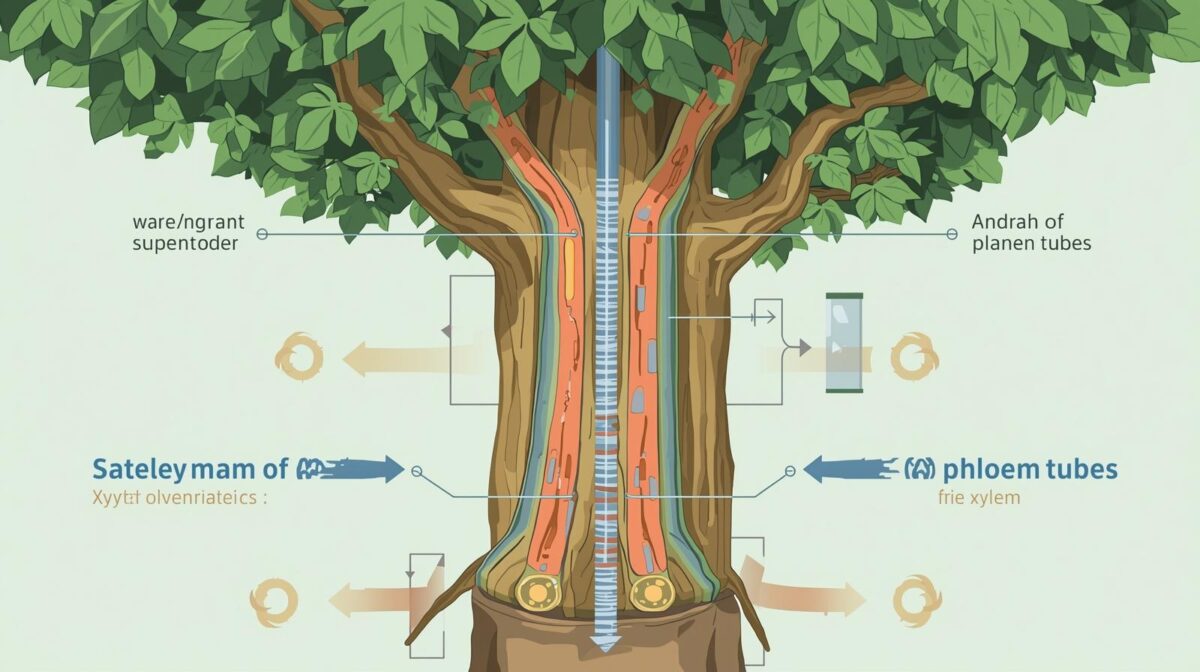
Branches and Twigs: The Structural Framework
If the trunk is a tree’s backbone, then branches and twigs form its skeletal framework the dynamic structure that supports leaves, flowers, and fruit. Their arrangement determines not only the tree’s shape but also how efficiently it captures sunlight, withstands weather, and grows from season to season.
Yet, improper pruning or misunderstanding how branches develop can lead to weak unions, poor form, and long-term structural problems that even the healthiest trunk cannot compensate for.
The Science of Branch Growth
Branch development is guided by a process called apical dominance, where the main terminal bud at the tip of a shoot suppresses the growth of lateral buds below it. This natural hierarchy helps trees maintain their upward growth habit while still developing a balanced canopy. When the terminal bud is removed or damaged through pruning, storm breakage, or insect activity lateral buds are activated, leading to new side branches.
The points where branches meet the trunk, known as branch unions, vary in strength. A strong union forms when the branch and trunk tissues overlap and interlock, as in oaks, maples, and elms. Weak unions, like those in Bradford pears or silver maples, have tight, V-shaped angles that trap bark inside the junction, increasing the risk of splitting during storms.
Branch Function and Seasonal Form
Branches serve as the distribution network for leaves, flowers, and fruit, optimizing their placement for maximum sunlight exposure and air circulation. During spring and summer, this framework is hidden beneath lush foliage. In winter, however, the bare branch structure reveals a tree’s underlying architecture its symmetry, strength, and pruning needs.
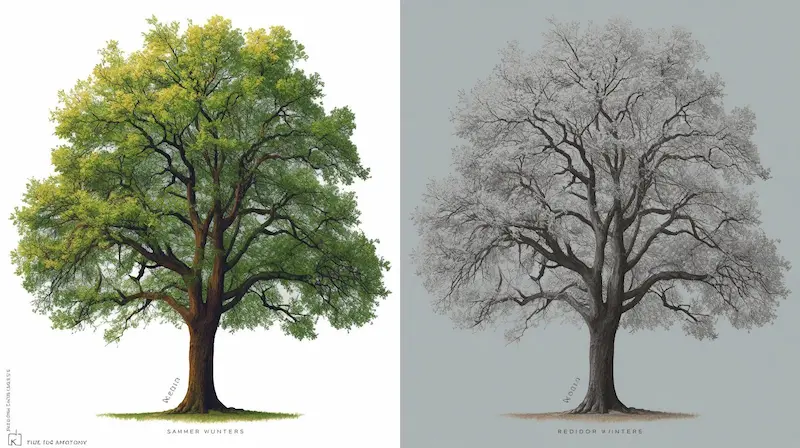
Understanding the Branch Collar
At the base of each branch, you’ll find a subtle swelling known as the branch collar a critical zone where trunk and branch tissues overlap. This area contains specialized cells that compartmentalize wounds when branches are naturally shed or pruned correctly.
Expert Tip Understand the Branch Collar:
When pruning, always cut just outside the branch collar never flush with the trunk. This allows the tree to seal the wound naturally, reducing the risk of decay, disease, or weak regrowth.
Product Recommendation Basic Bypass Pruning Shears:
A good pair of sharp bypass shears makes precise, clean cuts at the right angle. Proper pruning technique guided by an understanding of branch anatomy encourages faster healing and stronger regrowth.
Common Branch and Twig Types
|
Branch Type |
Description |
Typical Function / Appearance |
|
Main Branches |
Large, primary extensions from the trunk. |
Form the main scaffold that supports smaller branches; determine the tree’s overall shape and structure. |
|
Lateral Branches |
Smaller branches growing from main limbs. |
Fill out the canopy, carry leaves, flowers, and fruit; essential for energy production. |
|
Twigs |
The youngest, smallest woody growths. |
Bear buds, leaves, or flowers; often flexible; reveal annual growth rings when examined. |
|
Water Sprouts |
Vigorous upright shoots emerging from dormant buds on branches or the trunk. |
Usually weakly attached; often a sign of stress or over-pruning; best removed early. |
|
Suckers |
Shoots arising from the root collar or below ground. |
Compete with the main trunk for nutrients; should be pruned to maintain form and vigor. |
Real-World Examples and Structural Insights
- Strong-Structured Species: Oaks, beeches, and ginkgoes form wide branch angles and durable unions that resist storm damage.
- Weak-Structured Species: Bradford pears, willows, and poplars tend to produce narrow crotches and fast, brittle wood requiring more frequent pruning for safety.
Understanding how branches grow and connect allows gardeners to prune with purpose shaping the tree while protecting its natural systems of support and healing.
Leaves: The Powerhouses of Photosynthesis
Leaves are nature’s solar panels the living machinery that transforms sunlight into the energy trees need to grow, flower, and sustain life. While they may look delicate, each leaf is a highly efficient system designed for light capture, gas exchange, and water regulation. Understanding leaf anatomy and function not only helps with tree identification but also provides vital clues to a tree’s overall health.
Anatomy of a Leaf
Each part of the leaf serves a specific role in the process of photosynthesis and survival:
- Petiole: The slender stalk that connects the leaf blade to the stem, allowing flexibility and movement in the wind.
- Blade: The flat, broad surface that captures sunlight for photosynthesis. Its size and shape vary by species and growing conditions.
- Veins: The visible network of vascular bundles that transport water, nutrients, and sugars between the leaf and the rest of the tree.
- Stomata: Tiny pores on the underside of leaves that control gas exchange taking in carbon dioxide, releasing oxygen, and allowing water vapor to escape during transpiration.
Expert Tip Leaves Are Food Factories:
Every healthy leaf is a miniature production center, using sunlight, water, and carbon dioxide to create sugars through photosynthesis. Monitoring leaf health its color, size, and texture is the simplest way to gauge a tree’s energy production and overall vitality.
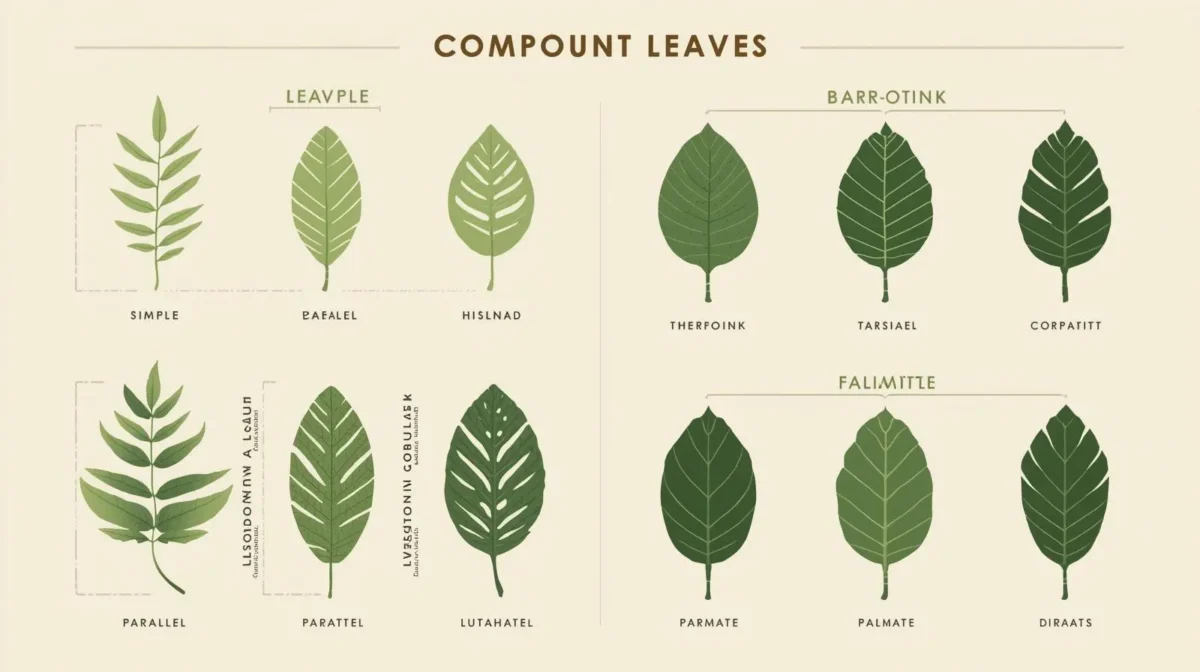
Leaf Types and Forms
- Simple Leaves: Have a single, undivided blade. Examples include oak, maple, and magnolia.
- Compound Leaves: Consist of multiple leaflets attached to a single petiole, as seen in ash, walnut, and horse chestnut.
Both types are adapted for specific environments simple leaves are often larger and more efficient for sunlight capture, while compound leaves improve airflow and reduce damage from wind or pests.
The Process of Photosynthesis and Transpiration
Through photosynthesis, chlorophyll in the leaves captures sunlight and uses it to combine carbon dioxide (from the air) and water (from the roots) into glucose (sugar) the tree’s main source of energy.
As part of this process, oxygen is released, enriching the air we breathe.
Meanwhile, stomata regulate water vapor loss in a process called transpiration. This continuous evaporation of moisture from leaves creates a gentle upward pull that draws water from the roots through the trunk keeping the entire tree hydrated.
Leaf Arrangement: A Key to Tree Identification
How leaves are arranged along the stem is one of the simplest and most reliable ways to identify tree species.
|
Leaf Arrangement |
Description |
Example Tree Species |
|
Alternate |
One leaf per node, staggered along the stem. |
Oak, Birch, Elm, Cherry. |
|
Opposite |
Two leaves per node, positioned directly across from each other. |
Maple, Ash, Dogwood, Boxwood. |
|
Whorled |
Three or more leaves per node, arranged in a circle around the stem. |
Catalpa, Rhododendron (some species), Sweet Woodruff. |
These patterns, combined with leaf shape and size, provide strong visual clues to distinguish between deciduous (leaf-shedding) and evergreen (year-round foliage) species.
Why Leaf Anatomy Matters
For homeowners and gardeners, understanding leaf anatomy is the gateway to better care. Discoloration, curling, or holes in leaves often signal nutrient deficiencies, pests, or root stress. By learning to “read” leaves, you can respond early adjusting watering, sunlight, or soil care before deeper problems develop.
Flowers, Fruits, and Seeds: The Reproductive System
Trees, like all living organisms, have one ultimate goal to reproduce and ensure the survival of their species. The flowers, fruits, and seeds are the key players in this life cycle, transforming energy and nutrients into the next generation of growth.
The Role of Flowers: Nature’s Reproductive Architects
Flowers are more than beautiful decorations they’re specialized reproductive structures that attract pollinators and enable fertilization. Each part of the flower serves a purpose:
- Petals draw in pollinators through color and scent.
- Stamens (male parts) produce pollen.
- Pistils (female parts) receive pollen and develop seeds after fertilization.
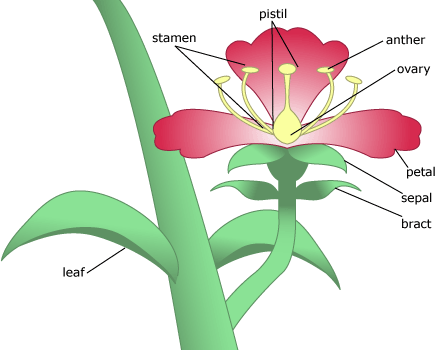
Differentiation Opportunity Anatomy Through the Seasons:
- Spring: Buds burst into bloom, attracting insects, birds, or even bats for pollination.
- Summer: Flowers fade as fertilized ovaries begin transforming into fruits.
- Autumn: Fruits mature, seeds harden, and dispersal begins.
- Winter: Most trees rest, conserving energy for the next cycle of renewal.
Understanding these phases helps gardeners and landscapers anticipate seasonal maintenance from pruning and fertilization to managing pollinator activity.
From Flower to Fruit: The Process of Fertilization
Once pollen reaches a flower’s pistil, it travels down to fertilize the ovule inside the ovary. That fertilized ovule becomes a seed, while the surrounding ovary tissue develops into a fruit.
This transformation is one of nature’s most efficient designs protecting the developing seeds while enticing animals or using natural forces for dispersal.
Expert Tip Observe the Transition:
By watching a flower turn into fruit, you can determine the health of both the pollination process and the tree’s overall vitality. A lack of fruit may signal poor pollinator presence, nutrient imbalance, or environmental stress.
Seeds: The Carriers of Future Forests
Each seed holds a tiny, dormant version of the parent tree, along with the nutrients it needs to begin life. But to spread and thrive, seeds rely on ingenious dispersal methods wind, water, and wildlife all play vital roles in this process.
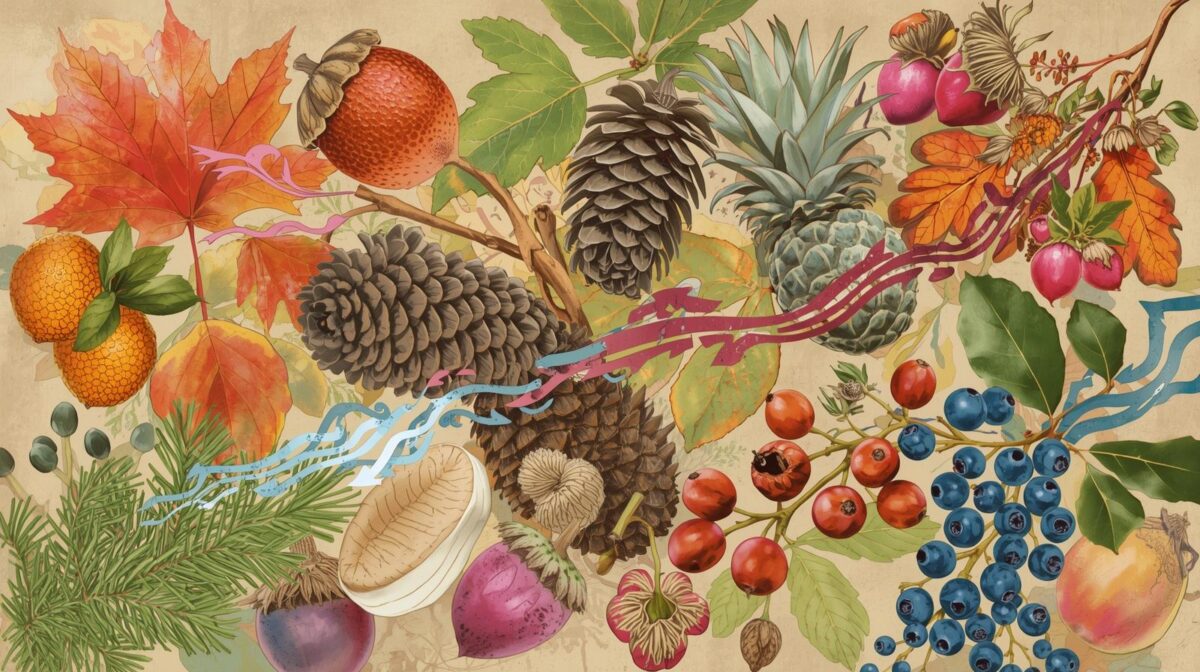
Common Tree Fruit and Seed Types
|
Fruit/Seed Type |
Description |
Primary Dispersal Method |
|
Samara |
Winged seed that spins or glides away from the parent tree. |
Wind (e.g., Maple, Ash, Elm) |
|
Acorn |
Hard nut with a cup-shaped cap (cupule). |
Animals (e.g., Oak) |
|
Berry |
Fleshy fruit containing multiple small seeds. |
Animals (e.g., Dogwood, Hawthorn, Holly) |
|
Cone |
Woody, scaly structure that protects seeds. Common in gymnosperms (non-flowering trees). |
Wind, Animals (e.g., Pine, Spruce, Fir) |
|
Drupe |
Fleshy fruit with a single hard pit containing the seed. |
Animals (e.g., Cherry, Peach, Plum) |
|
Legume |
Seed pod that splits open when dry, releasing seeds explosively. |
Bursting or Animals (e.g., Black Locust, Redbud) |
Each structure reflects a unique evolutionary strategy for ensuring seeds reach suitable soil and conditions to germinate.
Why Reproductive Anatomy Matters
Understanding how flowers, fruits, and seeds function isn’t just for botanists it’s practical knowledge for anyone caring for trees. Knowing when a tree blooms helps time pruning correctly. Recognizing fruiting patterns can guide fertilization and pest management.
E-E-A-T Consideration:
Use scientifically accurate illustrations of flower anatomy, seed structure, and dispersal types. This enhances comprehension while reinforcing credibility and educational value.
Would you like me to continue with the next section “The Crown and Canopy: The Tree’s Living Architecture” following this same framework (expert tips, differentiation, visual suggestions, and real-world application
How Tree Anatomy Solves Common Tree Problems
Understanding tree anatomy transforms guesswork into informed action. Many tree issues whether it’s wilting leaves, cracking bark, or poor fruiting can be traced directly to disruptions in specific anatomical functions. By learning what each part does and how it should look, you can identify early warning signs and take corrective measures before irreversible damage occurs.
1. Wilting or Yellowing Leaves → Xylem Dysfunction
When leaves wilt or turn yellow despite adequate watering, the issue often lies below the surface. The xylem, which transports water from roots to leaves, may be blocked or damaged.
Possible Causes:
- Root injury from construction or compacted soil.
- Fungal infections (e.g., Verticillium wilt) clogging vascular tissue.
- Overwatering leading to root rot.
Solution:
Improve soil aeration, reduce watering frequency, and check for root diseases. If caught early, trees can redirect energy into forming new, healthy xylem, supporting vigorous and fast-growing trees.
2. Bark Cracks and Cankers → Cambium or Phloem Injury
Deep bark fissures or sunken patches often signal damage to the cambium layer, the thin band of living cells responsible for radial growth.
Common Causes:
- Mechanical injury (e.g., lawn equipment).
- Frost cracks from sudden temperature drops.
- Insect borers tunneling beneath the bark.
Solution:
Avoid wounding bark, maintain mulch rings to prevent mower damage, and use proper pruning techniques. Healthy cambium ensures continuous growth of both xylem and phloem, the lifelines of the tree.
3. Poor Canopy Growth → Root or Soil Problems
When the top looks weak, the issue usually starts at the bottom. Sparse foliage, small leaves, or slow growth often point to unhealthy roots or compacted soil.
Possible Causes:
- Girdling roots constricting nutrient flow.
- Poor soil drainage or low oxygen levels.
- Root zone disturbance from digging or paving.
🌳 Solution:
Loosen soil, water deeply but infrequently, and check for girdling roots. Remember: a tree’s crown mirrors its roots.
4. Early Leaf Drop or Poor Flowering → Nutrient Transport Issues
If a tree blooms less or sheds leaves prematurely, it could indicate problems with phloem transport the flow of sugars and nutrients from leaves to other parts.
Possible Causes:
- Bark damage interrupting phloem continuity.
- Pest infestations draining nutrients.
- Nutrient deficiencies (especially nitrogen and potassium).
🌼 Solution:
Conduct a soil test and fertilize accordingly. Protect bark integrity and monitor for pest activity near the trunk base or main branches.
5. Decay and Cavities → Heartwood or Sapwood Compromise
Hollow or decaying areas in trunks or branches point to damage in heartwood (the tree’s structural core) or sapwood (the living outer wood).
Possible Causes:
- Fungal infections entering through wounds.
- Over-pruning or improper cuts near branch collars.
- Prolonged moisture exposure or poor air circulation.
🪵 Solution:
Remove decayed wood carefully and promote internal drying. Always make pruning cuts just outside the branch collar to let the tree compartmentalize naturally.
Expert Tip: Seek Professional Advice
For complex pruning, advanced decay, or uncertain diagnoses, consult a certified arborist. They can interpret anatomical symptoms with precision and apply science-backed techniques for restoration and care.
Glossary of Tree Anatomy Terms
A quick reference for key terms used throughout this guide concise, beginner-friendly, and consistent with the article’s language.
|
Term |
Definition |
|
Cambium |
A thin layer of living cells between the inner bark (phloem) and wood (xylem) that produces new tissue, allowing the tree to grow in girth. |
|
Phloem |
The living tissue beneath the bark that transports sugars made during photosynthesis from leaves to roots and fruits. |
|
Xylem |
The woody tissue that carries water and nutrients upward from the roots and provides structural support. |
|
Heartwood |
The dark, non-living central wood providing strength and storage for waste; no longer active in water transport. |
|
Sapwood |
The lighter, living outer wood that conducts water and nutrients from roots to leaves. |
|
Annual Ring |
A single year’s growth layer, visible as a ring in a trunk cross-section, showing seasonal growth differences. |
|
Lenticel |
Tiny raised pores on bark or fruits that allow gas exchange between inner tissues and the air. |
|
Root Collar |
The transition zone between trunk and roots often a critical site for disease or girdling root issues. |
|
Petiole |
The slender stalk connecting a leaf blade to its branch or stem. |
|
Stomata |
Microscopic pores on leaf surfaces that manage gas exchange and release water vapor. |
|
Photosynthesis |
The process where plants convert sunlight, water, and carbon dioxide into sugars for energy, releasing oxygen. |
|
Transpiration |
The release of water vapor from leaves, helping to cool the tree and draw water upward through the xylem. |
Conclusion: The Living System
A tree is far more than a trunk with leaves it’s a living system, a biological masterpiece where every part plays a critical role in harmony with the others. From the roots anchoring deep in the soil to the trunk lifting skyward, from the branches reaching outward to the leaves capturing sunlight, each component works in perfect coordination to sustain growth, strength, and resilience.
Together, these parts form an engineering marvel of nature a self-regulating, adaptive organism that can endure storms, drought, and the passage of decades, even centuries. For arborists and biologists, the tree represents one of nature’s most elegant designs: a seamless integration of structure and function that transforms sunlight, soil, and water into life itself.
Why Understanding Tree Anatomy Matters
Knowing how trees work beneath their bark empowers homeowners, gardeners, and land stewards to move beyond surface-level care. When you understand that:
- Roots mirror the crown,
- The trunk is a living transport system, and
- Leaves act as solar-powered factories,
you begin to see how every decision from where you plant to how you prune affects the tree’s health and longevity.
By applying this anatomical insight, you can diagnose problems early, promote natural healing, and nurture trees that thrive for generations. More than that, understanding tree anatomy deepens appreciation for their ecological role: stabilizing soil, producing oxygen, providing habitat, and enriching the landscapes we call home.
🌳 Expert Insight:
Certified arborists and plant biologists often describe trees as “ecosystems within themselves.” Recognizing their internal systems their vascular flow, protective layers, and growth patterns reveals the science behind their resilience and beauty.
Continue Learning: Tools for the Tree Enthusiast
Whether you’re a passionate gardener or an aspiring arborist, your journey into tree biology doesn’t end here. Deepen your understanding and enhance your field observations with these expert-recommended tools:
- 📘 High-Quality Tree Identification Field Guides:
Perfect for identifying species by bark, leaf shape, and growth habit.
Examples: “National Audubon Society Field Guide to North American Trees” or “Peterson Field Guide to Eastern/Central Trees.” - 📱 Digital Tree Identification Apps:
Explore trees interactively using AI-powered recognition and anatomical overlays. Examples: iNaturalist, LeafSnap, or Pl@ntNet. - 📗 Tree Biology & Arboriculture Textbooks:
For readers ready to go deeper into plant physiology and anatomy. Recommended titles: “Arboriculture: The Science and Practice of Tree Care” (Harris et al.), or “The Hidden Life of Trees” (Wohlleben) for an accessible ecological perspective.
A Final Word
Every tree tells a story written in its rings, whispered through its leaves, and sustained by the unseen life beneath the soil. By understanding tree anatomy, you’re not just learning biology; you’re cultivating connection.


